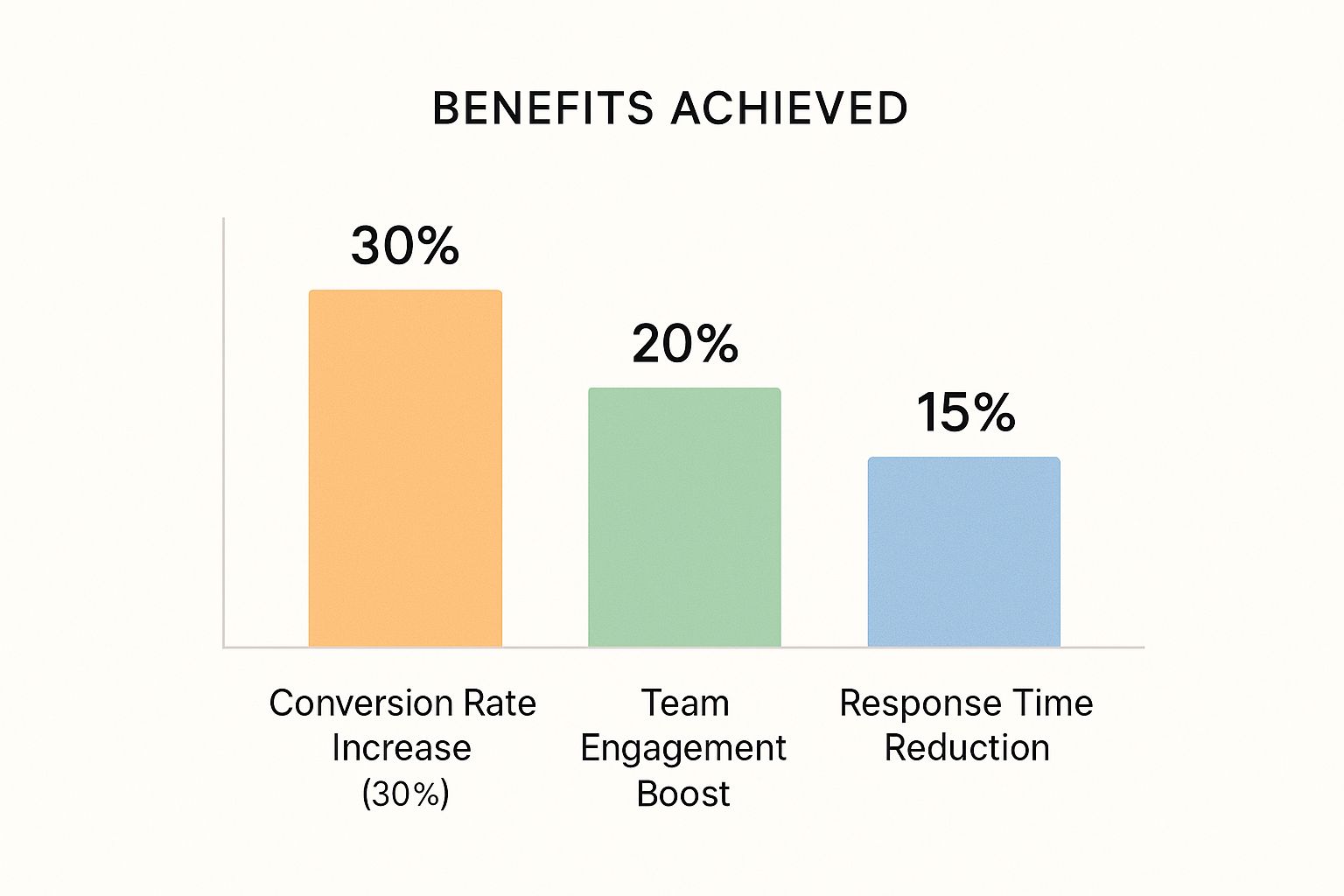Why Your SDR Performance Tracking Isn't Working

Let's get real for a moment: most SDR performance tracking systems are broken. You’ve probably seen it firsthand—a complex spreadsheet or a basic CRM dashboard that’s supposed to fuel friendly competition but instead creates a culture of anxiety. We hear it all the time from sales leaders: their well-intentioned SDR leaderboard slowly became something the team dreaded, not celebrated. The problem isn't a lack of data; it's a deep misunderstanding of what actually motivates an SDR.
Traditional tracking methods often miss the mark because they focus on the wrong metrics. It's simple to count the number of dials and emails sent, but these are just "vanity metrics" that don’t tell the whole story. One rep could make 100 dials and have zero meaningful conversations, while another makes 30 strategic calls that result in five qualified meetings. If your leaderboard only rewards raw activity, you’re praising busywork instead of effective work. This approach not only fails to recognize real effort but can also penalize reps for being thoughtful in their outreach.
When Rankings Backfire
The psychology of motivation is a tricky thing. Public rankings, a staple of many leaderboards, can be a double-edged sword. While they might light a fire under your top performers, they can be incredibly demoralizing for the rest of the team, especially new hires. Seeing your name at the bottom of a list day after day doesn't usually inspire a "never give up" attitude. More often, it leads to burnout and disengagement, turning competitive team members into people just watching the clock.
Sometimes, poor performance isn't about a lack of effort but about underlying stressors that kill productivity. Leaders need to understand the link between anxiety and productivity to create systems that truly support their teams. A leaderboard that only shows winners and losers completely ignores individual progress, learning curves, and other factors outside a rep's control.
The Real Cost of Poor Tracking
Bad performance tracking has very real consequences. When motivation drops, so does activity, and your sales pipeline is the first thing to suffer. SDRs are on the front lines, and in the tech and SaaS world, they are critical for growth. A staggering 74% of companies rely on teams of at least 21 SDRs to build their pipeline. You can dive deeper into how top companies structure their sales teams to see how vital this role is.
Getting SDR motivation right isn't just a "nice-to-have"; it’s essential for business. The best teams have figured this out. They've moved beyond simple rankings to build systems that visualize progress, celebrate small wins, and encourage collaboration. This guide will walk you through how to build an SDR leaderboard that your team will actually love.
Building Your SDR Leaderboard Foundation
Moving from a broken tracking system to one that actually works requires a real plan. You can't just plug in a new tool and expect magic. Creating a great SDR leaderboard is a lot like building a house—you need a solid foundation before you can even think about the paint colors. This foundation rests on clear goals, the right mix of metrics, and a genuine understanding of your team's culture. After all, the best leaderboards motivate everyone, not just the top 5%.
The first thing to do is get away from the "one-size-fits-all" approach. Your reps have different roles, so they need different ways to measure success. An SDR working on big enterprise accounts will have a longer sales cycle and higher deal values. On the other hand, a rep focused on SMBs is playing a high-volume game. A single leaderboard that ranks them both on "meetings booked" isn't just unfair; it’s misleading. A better way is to create separate leaderboards or use a weighted scoring system that reflects these differences, ensuring the competition is fair and acknowledges the unique grind each person faces.
Balancing Individual and Team Goals
One of the most common mistakes is making the SDR leaderboard all about individual glory. Yes, celebrating personal wins is crucial, but an exclusive focus on solo performance can quickly poison the well of collaboration. Before you know it, reps are hoarding promising leads or turning a blind eye when a teammate is struggling. To sidestep this, top-performing teams build leaderboards that recognize both individual hustle and collective achievements. For more on creating this kind of positive environment, you can check out our guide on building a high-performing SDR team.
Think about structuring your competitions with this balance in mind:
- Individual Sprints: These are great for weekly or monthly contests focused on personal metrics like meetings set or new opportunities created.
- Team Challenges: Set quarterly goals where the entire team pulls together to hit a big, shared target, like the total pipeline generated.
- Peer Recognition: Introduce a system where reps can give points to colleagues who helped them with a tricky account or offered great advice.
When you get this right, a well-designed leaderboard can have a huge effect on performance. This infographic shows the kind of improvements companies often see.

The numbers don't lie. The benefits go way beyond just hitting sales targets, boosting key operational metrics and making the team a better place to work. This balanced approach creates a culture where everyone is genuinely invested in each other's success, turning the SDR leaderboard from a source of stress into a powerful tool for motivation and growth.
Selecting Metrics That Drive Real Performance

With the foundation of your SDR leaderboard in place, it’s time to tackle the most important piece of the puzzle: choosing which metrics to track. This is where a great idea can quickly go wrong. If you only track activities like calls made or emails sent, you’re encouraging busywork, not effective work. Reps might start spamming contacts just to boost their numbers, which burns through leads and hurts your brand. A powerful leaderboard finds the right mix between effort and actual results.
Balancing Activities and Outcomes
The trick is to build a scoring system that rewards both the hustle and the wins. It’s like judging a basketball player—you don’t just count how many shots they take; you count how many baskets they make. For an SDR, this means pairing the actions they take every day with the results those actions produce.
- Leading Indicators (Activities): These are the daily efforts that set up future success. Think about meaningful conversations, personalized videos sent, or new high-value contacts added to a sequence. These are the inputs.
- Lagging Indicators (Outcomes): These are the tangible results, like meetings booked, opportunities qualified by sales, and pipeline generated. These are the outputs.
A frequent misstep is over-indexing on outcomes an SDR can't fully control, such as "deals closed." This is a quick way to demotivate your team, as their success becomes dependent on an Account Executive's performance. Instead, your leaderboard should celebrate outcomes they directly own, like meetings held or opportunities accepted by sales. This keeps them focused and motivated on the parts of the process they can influence. This philosophy is central to modern B2B outreach, a topic we cover more in our guide to B2B sales lead generation.
Designing a Weighted Scoring System
A weighted system is your best friend here. It lets you assign different point values to different metrics, showing your team exactly what the business values most. This design makes it much harder for reps to game the system by focusing on low-value, high-volume tasks.
Here’s what a simple, effective weighted model might look like:
| Metric | Points | Why It Works |
|---|---|---|
| New Conversation | 5 | Encourages opening doors and having quality interactions. |
| Meeting Booked | 15 | Rewards a primary objective of the SDR role. |
| Meeting Held | 25 | Values high-quality appointments that don't get canceled. |
| Opportunity Created | 50 | Directly ties SDR effort to building the sales pipeline. |
This point structure gives your reps a clear roadmap for success. They see that every action has value, but the actions that drive real business results are rewarded the most. To make these metrics truly sing, your team needs the skills to turn their efforts into wins. Applying some of the top sales training tips can help them improve their approach and see a direct impact on their leaderboard scores.
Setting Up Your Technical Infrastructure
A brilliant SDR leaderboard strategy is one thing; bringing it to life with the right technology is another. Without a solid technical setup, even the most creative plans can fall flat. Your goal should be a system that automatically pulls data, updates in real-time, and doesn't turn into a massive headache for your operations team to manage.
This entire process lives and breathes through your Customer Relationship Management (CRM) system. Your CRM is the single source of truth, making a seamless integration non-negotiable. Many teams see CRM updates as a chore rather than a tool for success, but the right setup can completely flip that script.
Integrating with Your CRM
First things first, you need to ensure your chosen leaderboard platform can communicate with your CRM without someone having to manually push and pull data all day. For major platforms like Salesforce, dedicated apps can make this process incredibly simple. The real work is in mapping the correct data fields from your CRM directly to the metrics on your leaderboard. This means when an SDR logs a call or updates an opportunity in Salesforce, it should pop up on the leaderboard almost instantly.
For instance, this is often the starting point for setting up an integrated app directly within the Salesforce environment.
This screenshot shows the Salesforce AppExchange, the marketplace for tools that integrate directly into the CRM. Using certified apps from here is a great way to automate your data flow. It helps ensure that your custom fields—like "Meeting Held" or "Opportunity Accepted"—sync correctly, preserving data integrity without forcing your reps into tedious manual entry.
Display and Visualization
Once the data is flowing smoothly, you need to think about how you'll show it off. Don't underestimate the power of a good visual. A leaderboard that’s buried three clicks deep in a forgotten CRM dashboard isn’t going to inspire anyone. Here are a few practical ways to keep the competition front and center:
- Dedicated TV Screens: Putting the SDR leaderboard on a large screen in a common office area is a classic for a reason. It creates public recognition and serves as a constant, visual reminder of team goals and who's leading the pack.
- Embedded Dashboards: Modern tools let you embed live leaderboards directly into the platforms your team practically lives in, like Slack or Microsoft Teams. This brings the competition to where the conversation is already happening.
- Personalized Views: Give each SDR a personal dashboard. This view should show their individual progress against their own goals, not just their rank compared to others. This is critical for keeping everyone motivated, not just your top 2-3 performers.
Creating Healthy Competition Without Toxic Results
An SDR leaderboard can be a powerful tool for motivation, but it's a double-edged sword. On one side, you get an energized team where healthy competition pushes everyone to do better. On the other, you can accidentally create a toxic culture that fuels resentment, encourages selfish actions, and leaves anyone not at the top feeling demoralized. The secret to landing on the right side isn’t in the software you use, but in the culture you build around the data. Your goal should be to make the leaderboard a source of team pride, not individual anxiety.
A frequent misstep is setting up a "winner-take-all" leaderboard. When only the #1 rep gets the spotlight, you're unintentionally telling the rest of your team that their efforts don't count. This is especially harmful to the steady, consistent performers who are the true foundation of any sales development team. Instead of fostering a cutthroat race to the top, great sales leaders design leaderboards that celebrate different kinds of success and value collaboration.
Embracing Collaborative Competition
To keep your SDR leaderboard from becoming a point of contention, you have to weave team-based goals into its fabric. This simple adjustment shifts the entire dynamic from "me vs. you" to "us vs. the goal," and the impact on your team's morale can be huge.
Here are a few ways to put this into practice:
- Team-Based Challenges: Establish a collective goal for the quarter, like hitting a certain pipeline generation number. If the whole team achieves it, everyone shares in the reward. This motivates your top reps to help mentor their peers because everyone's success is intertwined.
- Peer-to-Peer Recognition: Let reps give points to each other. Did someone share a fantastic cold call recording or help a teammate navigate a tough objection? Empower them to give out "kudos" points that feed into a separate "Most Valuable Teammate" leaderboard.
- Multiple 'Winner Circles': Don't limit celebrations to the person who books the most meetings. Create awards for other key achievements. You could have a "Most Improved Rep" award for the person with the biggest percentage jump over the last month or a "Quality King/Queen" award for the SDR with the best meeting-to-opportunity conversion rate.
This varied approach gives everyone a real chance at recognition. It validates different strengths and contributions, which is essential for building psychological safety. When your reps feel valued for more than just their rank, they're more likely to innovate, ask for support, and contribute to a genuinely positive team atmosphere.
Keeping It Fun and Fair
To maintain healthy competition and keep your SDRs engaged, consider using tools like gamification software. These platforms make it easy to introduce fun themes, run special contests, and offer a mix of rewards. You could organize a "March Madness" style bracket competition or a short-term sprint focused on a specific activity like new logo discovery. By keeping the challenges fresh, you prevent the leaderboard from feeling repetitive and give everyone a new shot at winning, which is key for sustaining motivation and morale over the long haul.
Keeping Your Leaderboard Fresh and Engaging

Even the most well-designed SDR leaderboard can lose its appeal if it’s left to stagnate. What begins as a powerful motivator can quickly blend into the office scenery, ignored like old wallpaper. To keep that from happening, you need a plan to keep it fresh and relevant. The idea is to evolve it strategically, not to constantly overhaul it and create confusion for your team.
A major warning sign of a stale leaderboard is when the same names occupy the top and bottom spots month after month. This predictability crushes motivation for nearly everyone. Top performers can grow complacent, while others might disengage entirely, feeling like the game isn't set up for them to win. When you see this pattern, it's a clear signal to shake things up.
Introducing Variety and Optimization
A fantastic way to keep your SDR leaderboard from getting old is to introduce short-term competitions and seasonal themes. Instead of a single, year-long marathon, think about running shorter sprints. These contests give the team a jolt of energy and offer everyone a clean slate with a fresh chance to win.
Here are a few ideas that have worked well for teams I've seen:
- Metric of the Month: In January, you might offer a bonus for the most meetings booked with your ideal customer profile. In February, the focus could shift to rewarding the highest number of new conversations initiated. This keeps everyone on their toes.
- Quarterly Team Challenges: Instead of individual glory, set a big, collective goal, like generating $100,000 in new pipeline as a team. This encourages collaboration, as your top reps have a real incentive to help their colleagues succeed for the shared victory.
- Power Hours or Blitz Days: Run a fast-paced, one-day competition centered around a single, high-impact activity. For example, you could have a "blitz day" focused on calling a list of high-intent prospects you've identified in your Salesloop.io dashboard.
To make sure your efforts are paying off, it helps to follow a simple optimization schedule. It doesn't have to be complicated; the goal is to have a framework for making changes and measuring their impact.
To keep your leaderboard from becoming background noise, it's important to have a regular schedule for reviewing and tweaking it. This table outlines a simple monthly and quarterly rhythm for keeping things effective.
Leaderboard Optimization Timeline
Monthly and quarterly optimization activities to keep your SDR leaderboard effective
| Time Period | Optimization Activity | Success Metrics | Red Flags to Watch For |
|---|---|---|---|
| Monthly | Introduce a short-term contest or "Metric of the Month." | High participation rates across the team; positive verbal feedback. | Drop-off in core metric performance; reps only focusing on the contest metric. |
| Quarterly | Review point weightings; gather team feedback on fairness. | Improved conversion rates (e.g., meetings held vs. booked). | Complaints about scoring; a decline in overall team morale or collaboration. |
| Annually | Assess the overall leaderboard structure and core KPIs. | Alignment with annual company goals; sustained high engagement. | The leaderboard no longer reflects key business priorities. |
Following a structured approach like this turns your SDR leaderboard from a simple scoreboard into a dynamic tool that evolves with your team. It becomes a lasting source of motivation that truly reflects what matters most to your business.
Measuring Success and Making Smart Adjustments
Alright, your leaderboard is up and running. The screens are on, the numbers are populating, and a little friendly competition is brewing. But let's get real for a second: Is it actually working? It's easy for an SDR leaderboard to become a fancy scoreboard that looks great but doesn't move the needle on what really counts for the business. To figure out if you're on the right path, you have to dig deeper than the surface numbers.
This is all about separating vanity metrics from true performance indicators. A huge spike in "dials made" might seem impressive, but if it doesn't translate into more qualified meetings, it's just activity for the sake of activity. Real success lies in the conversion rates between your key metrics. Are more conversations turning into more meetings booked? Are those booked meetings actually happening? These are the connections that show your team is not just working hard, but working smart.
Gathering Feedback and Making Data-Driven Changes
Data tells you what's happening, but your team can tell you why. Anonymous surveys are an incredible way to get honest feedback without putting anyone on the spot. Don't be shy; ask direct questions: "Does this leaderboard actually motivate you?" "Do you feel the scoring is fair?" "If you could change one thing about it, what would it be?" This kind of qualitative insight is priceless. For example, if multiple reps say they're discouraged by a heavy focus on lagging indicators, that's a clear signal to make a change. You could shift the focus to leading indicators, like rewarding progress within your sales cadence best practices.
When both the data and the team feedback point to a problem, it’s time to adjust. Pivoting isn't a sign you failed; it's a sign you're listening and leading effectively. When you make a change, frame it as an evolution driven by team input. This keeps everyone invested and shows you respect their experience on the front lines. The best leaders aren't afraid to admit something isn't working and try a different approach.
With Salesloop.io, you get the detailed analytics that make these adjustments straightforward. Our dashboards clearly show how team activities translate into a healthy pipeline. This helps you build a smarter, more effective SDR leaderboard that genuinely boosts performance.





